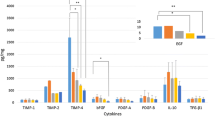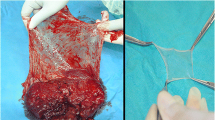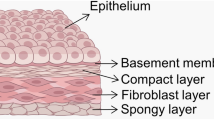Abstract
Preserved human amniotic membrane either air dried or glycerol preserved has been used effectively to treat superficial and partial thickness wounds without leaving any obvious hypertrophic scar. The preserved amnion, sterilised by ionising radiation, is known as an effective barrier for heat, fluid and protein loss while adheres nicely on wound. Air drying slightly reduced the oxygen transmission rate (OTR) of the amnion and the value significantly dropped after 15 kGy (p < 0.05). Glycerol preservation significantly reduced (p < 0.05) the OTR indicating less oxygen transmitted through the well structured cells of the amnion. Increase in the OTR with the increasing radiation doses up to 35 kGy possibly due to direct effects of radiation that resulted in large intercellular gaps. Both preservation methods significantly increased (p < 0.05) the water vapour transmission rate (WVTR). However, the low WVTR in the air dried amnion at 15 and 25 kGy was postulated due to cross-linking of collagen. Changes in the biophysical properties can be linked to direct and indirect effects of radiation on collagen bundles. The radiation dose of 25 kGy caused no adverse effect on biophysical properties hence it is still acceptable to sterilize both the air dried and the glycerol preserved amnions.




Similar content being viewed by others
References
Arya SK, Bhala S, Malik A, Sood S (2010) Role of amniotic membrane transplantation in ocular surface disorders. Nepal. J Ophthalmol 2(4):145–153
Branski LK, Herndon DN, Celis MM, Norbury WB, Masters OE, Jeschke MG (2008) Amnion in the treatment of pediatric partial-thickness facial burns. Burns 34:393–399
Bujang-Safawi E, Halim AS, Khoo TL, Dorai AA (2010) Dried irradiated human amniotic membrane as a biological dressing for facial burns—A 7-year case series. Burns 36(6):876–882
Dua HS, Gomes JAP, King AJ, Maharajan VS (2004) The amniotic membrane in ophthalmology. Surv Ophthalmol 49(1):51–77
Dziedzic-Goclawska A, Kaminski A, Uhrynowska-Tsyzkiewicz I, Stachowicz W (2005) Irradiation as a safety procedure in tissue banking. Cell Tissue Banking 6:201–209
Gross J, Schmitt FO (1948) The structure of human skin collagen as studied with the electron microscope. pp 29–32
Hilmy N, Siddik S, Gentur S, Gulardi W (1987) Physical and chemical properties of freeze dried amnion chorion membranes sterilized by γ-irradiation. Atom Indonesia 13:1–14
Hoeynck FV, Steinfeld AP, Becker J, Hermel M, Rath W, Hesselbarth U (2008) Sterilization and preservation influence the biophysical properties of human amnion grafts. Biologicals 36:248–255
Maral T, Borman H, Arslan H, Demirhan B, Akinbingol G, Haberal M (1999) Effectiveness of human amnion preserved long-term in glycerol as a temporary biological dressing. Burns 25(7):625–635
Martinez-Pardoa ME, Ley-Chavez E, Reyes-Frias ML, Rodriguez-Ferreyra P, Vazquez-Maya L, Salazar MA (2007) Biological wound dressings sterilized with gamma radiation: Mexican clinical experience. Radiat Phys Chem 76:1771–1774
Mohamad H (2007) Amnion for treatment of burns. In: Nather A, Yusof N, Hilmy N (eds) Radiation in tissue banking. World Scientific, Singapore, pp 343–354
Nangia A, Gambhir R, Maibach H (1991) Factors influencing the performance of temporary skin subtitues. Clin Mater 7:3–13
Nguyen H, Morgan DAF, Forwood MR (2007a) Sterilization of allografts bone: is 25 kGy the gold standard for gamma irradiation? Cell Tissue Banking 8:81–91
Nguyen H, Morgan DAF, Forwood MR (2007b) Sterilization of allograft bone: effects of gamma irradiation on allograft biology and biomechanics. Cell Tissue Banking 8:93–105
Niknejad H, Peirovi H, Jorjani M, Ahmadiani A, Ghanavi J, Seifalian MA (2008) Properties of the amniotic membrane for potential use in tissue engineering. Eur Cells Mater 15:88–99
Rejzek A, Weyer F, Eichberger R, Gebhart W (2001) Physical changes of amniotic membranes through glycerolization for the use as an epidermal substitute. Light and electron microscopic studies. Cell Tissue Banking 2:95–102
Riau AK, Beuerman RW, Lim LS, Mehta JS (2010) Preservation, sterilization and de-epithelialization of human amniotic membrane for use in ocular surface reconstruction. Biomaterials 31:216–225
Rooney P, Eagle M, Hogg P, Lomas R, Kearney J (2008) Sterilisation of skin allograft with gamma irradiation. Burns 34(6):64–67
Singh R, Charcharkar MP (2011) Dried gamma-radiated amniotic membrane as dressing in burn wound care. J Tissue Viability 20:49–54
Singh R, Gupta P, Kumar P, Kumar A, Chacharkar MP (2003) Properties of air dried radiation processed amniotic membranes under different storage conditions. Cell Tissue Banking 4:95–100
Singh R, Chouhan US, Purohit S, Gupta P, Kumar P, Kumar A, Charcharkar MP, Kachhawa D, Ghiya BC (2004) Radiation processed amniotic membranes in the treatment of non healing ulcers of different etiologies. Cell Tissue Banking 5:129–134
Singh R, Purohit S, Chacharkar MP (2007) Effect of high doses of gamma radiation on the functional characteristics of amniotic membrane. Radiat Phys Chem 76:1026–1030
Subrahmanyam M (1995) Amniotic membrane as a cover for microskin grafts. Br J Plast Surg 48:477–478
Suzina SAH, Nor Kamalia Z, Yusof N, Asnah H (2014) Scanning electron microscopic assessment on surface morphology of preserved human amniotic membrane after gamma sterilisation. Cell Tissue Banking 15:15–24
Thomasen H, Pauklin M, Steuhl KP, Meller D (2009) Comparison of cryopreserved and air- dried human amniotic membrane for ophthalmologic applications. Graefes Arch Clin Exp Ophthalmol 247:1691–1700
Yusof N (1994) The use of gamma irradiation for sterilization of bones and amnions. Malays J Nucl Sci 12:243–251
Yusof N, Asnah H (1995) Processing cost for routine production of radiation sterilised amnions. In: Proceedings of the Malaysian science and technology congress, vol. 3, Kuala Lumpur, pp 76–83
Yusof N, Hilmy N (2007) Physical and mechanical properties of radiation sterilised amnion. In: Nather A, Yusof N, Hilmy N (eds) Radiation in tissue banking. World Scientific, Singapore, pp 155–168
Acknowledgments
This study was supported by International Atomic Energy Agency, IAEA (Contract No. 16099/RO), Universiti Sains Malaysia Short Term Grant (306/PPSP/61311008) and Malaysian Technology Development Cooperation (No. 304/PPSP.6150093.M130). We thank staffs of Tissue Bank of Universiti Sains Malaysia, Ms Asnah Hassan and staffs of MINTec-Sinagama of Malaysian Nuclear Agency, and staffs of Biomaterial Laboratory of AMREC SIRIM for their cooperation and assistance.
Author information
Authors and Affiliations
Corresponding author
Rights and permissions
About this article
Cite this article
Zahari, N.K., Sheikh Ab Hamid, S. & Yusof, N. Effects of different doses of gamma irradiation on oxygen and water vapour transmission rate of preserved human amniotic membrane. Cell Tissue Bank 16, 55–63 (2015). https://doi.org/10.1007/s10561-014-9438-9
Received:
Accepted:
Published:
Issue Date:
DOI: https://doi.org/10.1007/s10561-014-9438-9




